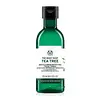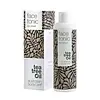What's inside
What's inside
 Key Ingredients
Key Ingredients

 Benefits
Benefits

 Concerns
Concerns

 Ingredients Side-by-side
Ingredients Side-by-side

Water
Skin ConditioningAlcohol Denat.
AntimicrobialTapioca Starch Polymethylsilsesquioxane
AbsorbentCaprylyl Glycol
EmollientPEG-40 Hydrogenated Castor Oil
EmulsifyingHamamelis Virginiana Water
AstringentGlycerin
HumectantSalix Alba Bark Extract
AstringentMelaleuca Alternifolia Leaf Oil
AntioxidantAlcohol
AntimicrobialAllantoin
Skin ConditioningCalophyllum Inophyllum Seed Oil
AntimicrobialSodium Hydroxide
BufferingLimonene
PerfumingCitral
PerfumingCitronellol
PerfumingLeptospermum Petersonii Oil
MaskingCaramel
Cosmetic ColorantCI 19140
Cosmetic ColorantCI 42090
Cosmetic ColorantWater, Alcohol Denat., Tapioca Starch Polymethylsilsesquioxane, Caprylyl Glycol, PEG-40 Hydrogenated Castor Oil, Hamamelis Virginiana Water, Glycerin, Salix Alba Bark Extract, Melaleuca Alternifolia Leaf Oil, Alcohol, Allantoin, Calophyllum Inophyllum Seed Oil, Sodium Hydroxide, Limonene, Citral, Citronellol, Leptospermum Petersonii Oil, Caramel, CI 19140, CI 42090
Water
Skin ConditioningPEG-40 Hydrogenated Castor Oil
EmulsifyingPEG-7 Glyceryl Cocoate
EmulsifyingGlycerin
HumectantTriethyl Citrate
MaskingSaccharide Isomerate
HumectantPhenoxyethanol
PreservativeMelaleuca Alternifolia Leaf Oil
AntioxidantSodium PCA
HumectantAllantoin
Skin ConditioningPotassium Sorbate
PreservativeSodium Benzoate
MaskingLactic Acid
BufferingTocopherol
AntioxidantTerminalia Ferdinandiana Fruit Extract
AntioxidantCitric Acid
BufferingSodium Citrate
BufferingLimonene
PerfumingWater, PEG-40 Hydrogenated Castor Oil, PEG-7 Glyceryl Cocoate, Glycerin, Triethyl Citrate, Saccharide Isomerate, Phenoxyethanol, Melaleuca Alternifolia Leaf Oil, Sodium PCA, Allantoin, Potassium Sorbate, Sodium Benzoate, Lactic Acid, Tocopherol, Terminalia Ferdinandiana Fruit Extract, Citric Acid, Sodium Citrate, Limonene
 Reviews
Reviews

Ingredients Explained
These ingredients are found in both products.
Ingredients higher up in an ingredient list are typically present in a larger amount.
Allantoin is a soothing ingredient known for its protective and moisturizingg properties. Because of this, it is often added to products with strong active ingredients.
Studies show higher concentrations of this ingredient can promote wound healing.
Though it can be derived from the comfrey plant, allantoin is produced synthetically for cosmetic products to ensure purity.
Learn more about AllantoinGlycerin is already naturally found in your skin. It helps moisturize and protect your skin.
A study from 2016 found glycerin to be more effective as a humectant than AHAs and hyaluronic acid.
As a humectant, it helps the skin stay hydrated by pulling moisture to your skin. The low molecular weight of glycerin allows it to pull moisture into the deeper layers of your skin.
Hydrated skin improves your skin barrier; Your skin barrier helps protect against irritants and bacteria.
Glycerin has also been found to have antimicrobial and antiviral properties. Due to these properties, glycerin is often used in wound and burn treatments.
In cosmetics, glycerin is usually derived from plants such as soybean or palm. However, it can also be sourced from animals, such as tallow or animal fat.
This ingredient is organic, colorless, odorless, and non-toxic.
Glycerin is the name for this ingredient in American English. British English uses Glycerol/Glycerine.
Learn more about GlycerinLimonene is a fragrance that adds scent and taste to a formulation.
It's found in the peel oil of citrus fruits and other plants such as lavender and eucalyptus. The scent of limonene is generally described as "sweet citrus".
Limonene acts as an antioxidant, meaning it helps neutralize free radicals.
When exposed to air, oxidized limonene may sensitize the skin. Because of this, limonene is often avoided by people with sensitive skin.
The term 'fragrance' is not regulated in many countries. In many cases, it is up to the brand to define this term. For instance, many brands choose to label themselves as "fragrance-free" because they are not using synthetic fragrances. However, their products may still contain ingredients such as essential oils that are considered a fragrance.
Learn more about LimoneneThis tea tree oil comes from the leaves of the Tea Tree plant. Tea tree oil has antioxidant, anti-inflammatory, and antimicrobial properties.
According to the book Journal of Profiles of Drug Substances, tea tree helps in reducing acne-causing bacteria such as Propionibacterium acnes. This is due to the Terpinen components of tea tree oil.
Tea tree may cause sensitivity and irritation for some people. This oil naturally contains fragrance such as linalool and limonene.
However, research shows irritation usually occurs when using pure tea tree oil and not in cosmetic products.
Tea tree oil was found to help relieve the symptoms of psoriasis in one study.
Tea tree oil is toxic when ingested. Another study showed it to caused damage to the nervous system of dogs and cats when applied to their skin or given orally.
Learn more about Melaleuca Alternifolia Leaf OilPeg-40 Hydrogenated Castor Oil is derived from castor oil and polyethylene glycol (PEG). It is used as a emollient and emulsifier.
As an emulsifier, it helps prevent ingredients from separating. It also helps make the other ingredients more soluble; it is often used to solubilize fragrances. This increases spreadability and elongates shelf life in a product.
Emollients help soothe and soften the skin. They do this by creating a protective film on your skin. This barrier helps trap moisture and keeps your skin hydrated. Emollients may be effective at treating dry or itchy skin.
This ingredient may or may not be vegan, depending on the source.
Peg-40 Hydrogenated Castor Oil may not be fungal-acne safe. We recommend speaking with a professional if you have any questions or concerns.
Learn more about PEG-40 Hydrogenated Castor OilWater. It's the most common cosmetic ingredient of all. You'll usually see it at the top of ingredient lists, meaning that it makes up the largest part of the product.
So why is it so popular? Water most often acts as a solvent - this means that it helps dissolve other ingredients into the formulation.
You'll also recognize water as that liquid we all need to stay alive. If you see this, drink a glass of water. Stay hydrated!
Learn more about Water